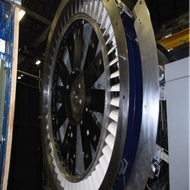A unique and one-off facility, the Deverson compressor continues to set the standard for state-of-the-art compressor aerodynamics research.
The Deverson compressor is a large-scale low-speed, single-stage, axial-flow compressor, as shown in Figure 1.
Figure 1 - The Deverson Compressor
Ambient air is drawn into a 3400 mm diameter bell-mouth inlet through a thick gauze. The airstream passes through a honeycomb grid and two additional wire gauzes designed to straighten the flow. Following a 9:1 area contraction, the flow enters a parallel annulus with a mean radius of 762 mm and a hub-to-tip ratio of 0.8. The airstream then passes through a turbulence grid, a row a forty-nine inlet guide vanes (IGV), fifty-one rotor blades and forty-nine stator blades. The stator blades have a modern three-dimensional design, a chord length of 132.4 mm and a pitch-to-chord ratio of 0.8. Downstream of the stator row trailing edge, the cylindrical annulus continues for sixteen stator chord lengths before the airstream exits into a dump diffuser. A conical throttle valve and an auxiliary fan positioned at the rear of the machine are used to set the flow rate through the compressor, which can be controlled independently of the rotor speed. An additional benefit on the Deverson is the ability to split the working section just upstream of the rotor inlet plane, as shown in Figure 2.
Figure 2 - The Deverson Rotor
This design feature simplifies internal access to the machine and allows for rapid re-blading, re-instrumentation and maintenance over the course of time-intensive measurement campaigns.
The Deverson compressor ranks amongst the most important experimental facilities housed within the Whittle Laboratory. Due to its sheer size and versatility, a number of sophisticated experimental techniques can be applied to this machine including: (i) ethylene tracer gas techniques; (ii) hot-wire anemometry; (iii) high-response pressure probes and (iv) endoscopic particle image velocimetry. Measurements can be acquired in both the stationary and rotating frames, with the latter made possible using a slip-ring arrangement. Measurements acquired inside the Deverson have led to a number of groundbreaking advancements in turbomachinery aerodynamics including studies related to: (i) rotating stall; (ii) rotor-stator interactions and (iii) radial mixing.
Key facts & applications
Some facts and applications of the Deverson are listed below.
Key facts
- Engine-scale Reynolds numbers, ~ 3x10^5.
- Mean casing diameter of 1.542 m.
- Low Mach number <0.1.
Applications
- Stall inception studies.
- Secondary flow studies.
- Turbulent loss mechanisms.
